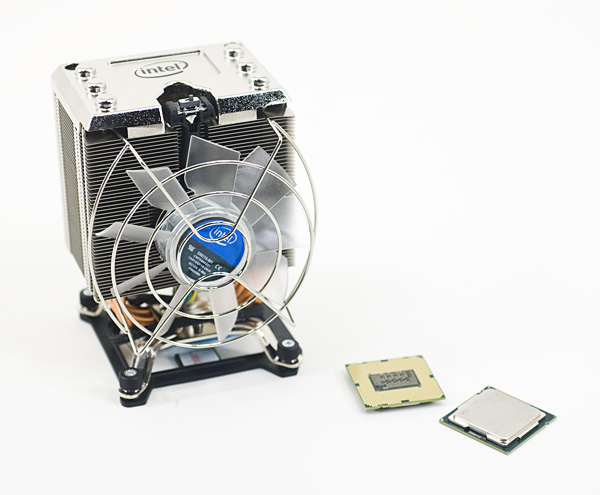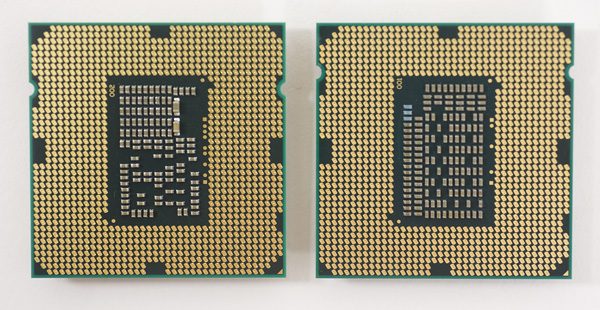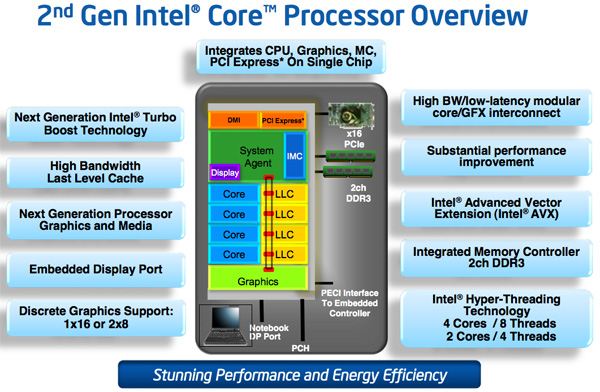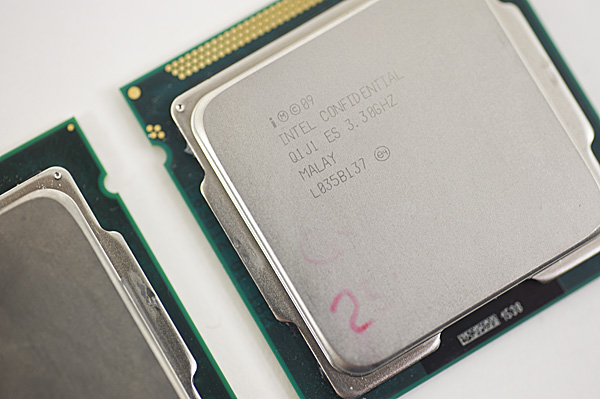The Sandy Bridge Review: Intel Core i7-2600K, i5-2500K and Core i3-2100 Tested
by Anand Lal Shimpi on January 3, 2011 12:01 AM ESTIntel never quite reached 4GHz with the Pentium 4. Despite being on a dedicated quest for gigahertz the company stopped short and the best we ever got was 3.8GHz. Within a year the clock (no pun intended) was reset and we were all running Core 2 Duos at under 3GHz. With each subsequent generation Intel inched those clock speeds higher, but preferred to gain performance through efficiency rather than frequency.
Today, Intel quietly finishes what it started nearly a decade ago. When running a single threaded application, the Core i7-2600K will power gate three of its four cores and turbo the fourth core as high as 3.8GHz. Even with two cores active, the 32nm chip can run them both up to 3.7GHz. The only thing keeping us from 4GHz is a lack of competition to be honest. Relying on single-click motherboard auto-overclocking alone, the 2600K is easily at 4.4GHz. For those of you who want more, 4.6-4.8GHz is within reason. All on air, without any exotic cooling.
Unlike Lynnfield, Sandy Bridge isn’t just about turbo (although Sandy Bridge’s turbo modes are quite awesome). Architecturally it’s the biggest change we’ve seen since Conroe, although looking at a high level block diagram you wouldn’t be able to tell. Architecture width hasn’t changed, but internally SNB features a complete redesign of the Out of Order execution engine, a more efficient front end (courtesy of the decoded µop cache) and a very high bandwidth ring bus. The L3 cache is also lower and the memory controller is much faster. I’ve gone through the architectural improvements in detail here. The end result is better performance all around. For the same money as you would’ve spent last year, you can expect anywhere from 10-50% more performance in existing applications and games from Sandy Bridge.
I mentioned Lynnfield because the performance mainstream quad-core segment hasn’t seen an update from Intel since its introduction in 2009. Sandy Bridge is here to fix that. The architecture will be available, at least initially, in both dual and quad-core flavors for mobile and desktop (our full look at mobile Sandy Bridge is here). By the end of the year we’ll have a six core version as well for the high-end desktop market, not to mention countless Xeon branded SKUs for servers.
The quad-core desktop Sandy Bridge die clocks in at 995 million transistors. We’ll have to wait for Ivy Bridge to break a billion in the mainstream. Encompassed within that transistor count are 114 million transistors dedicated to what Intel now calls Processor Graphics. Internally it’s referred to as the Gen 6.0 Processor Graphics Controller or GT for short. This is a DX10 graphics core that shares little in common with its predecessor. Like the SNB CPU architecture, the GT core architecture has been revamped and optimized to increase IPC. As we mentioned in our Sandy Bridge Preview article, Intel’s new integrated graphics is enough to make $40-$50 discrete GPUs redundant. For the first time since the i740, Intel is taking 3D graphics performance seriously.
| CPU Specification Comparison | ||||||||
| CPU | Manufacturing Process | Cores | Transistor Count | Die Size | ||||
| AMD Thuban 6C | 45nm | 6 | 904M | 346mm2 | ||||
| AMD Deneb 4C | 45nm | 4 | 758M | 258mm2 | ||||
| Intel Gulftown 6C | 32nm | 6 | 1.17B | 240mm2 | ||||
| Intel Nehalem/Bloomfield 4C | 45nm | 4 | 731M | 263mm2 | ||||
| Intel Sandy Bridge 4C | 32nm | 4 | 995M | 216mm2 | ||||
| Intel Lynnfield 4C | 45nm | 4 | 774M | 296mm2 | ||||
| Intel Clarkdale 2C | 32nm | 2 | 384M | 81mm2 | ||||
| Intel Sandy Bridge 2C (GT1) | 32nm | 2 | 504M | 131mm2 | ||||
| Intel Sandy Bridge 2C (GT2) | 32nm | 2 | 624M | 149mm2 | ||||
It’s not all about hardware either. Game testing and driver validation actually has real money behind it at Intel. We’ll see how this progresses over time, but graphics at Intel today very different than it has ever been.
Despite the heavy spending on an on-die GPU, the focus of Sandy Bridge is still improving CPU performance: each core requires 55 million transistors. A complete quad-core Sandy Bridge die measures 216mm2, only 2mm2 larger than the old Core 2 Quad 9000 series (but much, much faster).
As a concession to advancements in GPU computing rather than build SNB’s GPU into a general purpose compute monster Intel outfitted the chip with a small amount of fixed function hardware to enable hardware video transcoding. The marketing folks at Intel call this Quick Sync technology. And for the first time I’ll say that the marketing name doesn’t do the technology justice: Quick Sync puts all previous attempts at GPU accelerated video transcoding to shame. It’s that fast.
There’s also the overclocking controversy. Sandy Bridge is all about integration and thus the clock generator has been moved off of the motherboard and on to the chipset, where its frequency is almost completely locked. BCLK overclocking is dead. Thankfully for some of the chips we care about, Intel will offer fully unlocked versions for the enthusiast community. And these are likely the ones you’ll want to buy. Here’s a preview of what’s to come:
The lower end chips are fully locked. We had difficulty recommending most of the Clarkdale lineup and I wouldn’t be surprised if we have that same problem going forward at the very low-end of the SNB family. AMD will be free to compete for marketshare down there just as it is today.
With the CPU comes a new platform as well. In order to maintain its healthy profit margins Intel breaks backwards compatibility (and thus avoids validation) with existing LGA-1156 motherboards, Sandy Bridge requires a new LGA-1155 motherboard equipped with a 6-series chipset. You can re-use your old heatsinks however.

Clarkdale (left) vs. Sandy Bridge (right)
The new chipset brings 6Gbps SATA support (2 ports) but still no native USB 3.0. That’ll be a 2012 thing it seems.













283 Comments
View All Comments
aviat72 - Tuesday, January 4, 2011 - link
Though SB will be great for some applications, there are still rough edges in terms of the overall platform. I think it will be best to wait for SNB-E or at least the Z68. SNB-E seems to be the best future-proofing bet.I also wonder how a part rated for 95W TDP was drawing 111W in the 4.4GHz OC (the Power Consumption Page). SB's power budget controller must be really smart to allow the higher performance without throttling down, assuming your cooling system can manage the thermals.
marraco - Tuesday, January 4, 2011 - link
I wish to know more about this Sandy Bridge "feature":http://www.theinquirer.net/inquirer/news/1934536/i...
PeterO - Tuesday, January 4, 2011 - link
Anand, Thanks for the great schooling and deep test results -- something surely representing an enormous amount of time to write, produce, and massage within Intel's bumped-forward official announcement date.Here's a crazy work-around question:
Can I have my Quick Synch cake and eat my Single-monitor-with-Discrete-Graphics-card too if I, say:
1). set my discrete card output to mirror Sandy Bridge's IGP display output;
2). and, (should something exist), add some kind of signal loopback adapter to the IGP port to spoof the presence of a monitor? A null modem, of sorts?
-- I have absolutely no mobo/video signaling background, so my idea may be laugh in my face funny to anybody who does but I figure it's worth a post, if only for your entertainment. :)
Hrel - Wednesday, January 5, 2011 - link
It makes me SO angry when Intel does stupid shit like disable HT on most of their CPU's even though the damn CPU already has it on it, they already paid for. It literally wouldn't cost them ANYTHING to turn HT on those CPU's yet the greedy bastards don't do it.Moizy - Wednesday, January 5, 2011 - link
The HD Graphics 3000 performance is pretty impressive, but won't be utilized by most. Most who utilize Intel desktop graphics will be using the HD Graphics 2000, which is okay, but I ran back to the AMD Brazos performance review to get some comparisons.In Modern Warfare 2, at 1024 x 768, the new Intel HD Graphics 2000 in the Core i3 2100 barely bests the E-350. Hmm--that's when it's coupled with a full-powered, hyper-threaded desktop compute core that would run circles around the compute side of the Brazos E-350, an 18w, ultra-thin chip.
This either makes Intel's graphics less impressive, or AMD's more impressive. For me, I'm more impressed with the graphics power in the 18w Brazos chip, and I'm very excited by what mainstream Llano desktop chips (65w - 95w) will bring, graphics-wise. Should be the perfect HTPC solution, all on the CPU (ahem, APU, I mean).
I'm very impressed with Intel's video transcoding, however. Makes CUDA seem...less impressive, like a bunch of whoop-la. Scary what Intel can do when it decides that it cares about doing it.
andywuwei - Wednesday, January 5, 2011 - link
not sure if anybody else noticed. CPU temp of the i5@3.2GHz is ~140 degrees. any idea why it is so high?SantaAna12 - Wednesday, January 5, 2011 - link
Did I miss the part where you tell of about the DRM built into this chip?Cb422 - Wednesday, January 5, 2011 - link
When will Sandy Bridge be available on Newegg or Amazon for me to purchase?DesktopMan - Thursday, January 6, 2011 - link
Very disappointed in the lack of vt-d and txt on k-variants. They are after all the high end products. I also find the fact that only the k-variants having the faster GPU very peculiar, as those are the CPUs most likely to be paired with a discrete GPU.RagingDragon - Thursday, January 6, 2011 - link
Agreed. I find the exclusion of VT-d particularly irritating: many of the overclockers and enthusiasts to whom the K chips are marketed also use virtualization. Though I don't expect many enthusiasts, if any, to miss TXT (it's more for locked down corporate systems, media appliances, game consoles, etc.).With the Z68 chipset coming in the indeterminate near future, the faster GPU on K chips would have made sense if the K chips came with every other feature enabled (i.e. if they were the "do eveything chips").
Also, I'd like to have the Sandy Bridge video encode/decode features separate from the GPU functionality - i.e. I'd like to choose between Intel and Nvidia/AMD video decode/encode when using a discrete GPU.